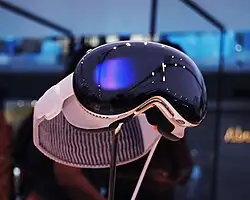Apple Vision ‘Air’: A More Affordable and Lightweight AR Headset on the Horizon
Apple has long been a trailblazer in the world of consumer electronics. With the introduction of the Vision Pro last year, the tech giant entered the augmented reality (AR) space in a major way. But Apple isn’t stopping there. Reports suggest that the company is preparing to launch a more affordable and lightweight version of its Vision headset—tentatively called the Apple Vision ‘Air’—in 2025. While the details are still emerging, the ‘Air’ could offer consumers a more accessible entry into AR, with a focus on portability and ease of use.

A Lighter, More Accessible Vision
The Apple Vision Pro, which debuted with great fanfare in 2023, introduced a sophisticated and powerful AR headset. However, it also came with a hefty price tag. At around $3,499, it targeted developers, professionals, and enthusiasts rather than the general consumer. Now, Apple looks to change the game by offering a more budget-friendly alternative.
Sources indicate that the Vision ‘Air’ will be much lighter and more compact than the Vision Pro. While the latter required a substantial power supply and heavy hardware, the ‘Air’ model will focus on portability. The new design will make it easier for users to wear the headset for extended periods.
Apple’s goal with the Vision ‘Air’ is clear: to create an entry-level AR headset that can bring immersive experiences to a broader audience without compromising quality. The Vision Pro offered a range of advanced features, including high-resolution displays, powerful sensors, and a custom processing chip. The Vision ‘Air,’ however, will streamline many of these features. It will aim to provide a high-quality AR experience at a more affordable price point, making it more comfortable for everyday use and suitable for casual users who want to explore AR technology.
Not Fully Independent: A Need for Connection to iPhone or Mac
While the Vision Pro operates independently, sources suggest that the Vision ‘Air’ will require an iPhone or Mac to function. This connection could be a crucial factor in lowering the price of the headset.
The external connection suggests that the Vision ‘Air’ will not have the same powerful onboard chip as the Vision Pro. Instead, it will rely on the power of the connected device—be it an iPhone or Mac—to handle tasks like rendering graphics, processing data, and managing storage. This design reduces the complexity and cost of the headset while still delivering a rich AR experience through the connected Apple device.
Although this dependency limits the Vision ‘Air’s capabilities compared to the Vision Pro, it makes the headset more appealing for users already embedded in the Apple ecosystem. For example, people who own the latest iPhone or Mac will find the ‘Air’ headset a convenient addition to their device lineup.
Features and Design: What to Expect from the Vision ‘Air’
Although official details about the Vision ‘Air’ remain limited, we can speculate on the potential design and features based on current trends. Apple is known for its minimalist, sleek designs, and the Vision ‘Air’ will likely follow this same aesthetic. Expect lightweight, durable materials that prioritize comfort without sacrificing style.
The headset will likely feature high-resolution displays, though perhaps not as advanced as the Vision Pro’s. The Vision ‘Air’ will provide vibrant, crisp visuals for AR experiences. AR is all about blending the digital world with the physical, and clear visuals will be key to achieving that seamless integration.
In terms of functionality, the Vision ‘Air’ will include various sensors to track hand gestures, eye movement, and environmental factors. These sensors will allow users to interact naturally with the AR experience. Apple may also include some spatial audio features, similar to the Vision Pro, to enhance the experience without the need for external headphones.
While the Vision ‘Air’ may not boast the same sophisticated tracking and spatial awareness as the Vision Pro, it will likely excel in providing users with basic AR experiences, such as virtual workspaces, simple gaming, and interactive media consumption. The headset might not handle highly complex AR tasks, but it will still deliver immersive experiences that make AR accessible to everyday users.
The Market for Affordable AR Headsets
With the rumored release of the Vision ‘Air,’ Apple could tap into the growing demand for affordable AR headsets. Companies like Meta (formerly Facebook) and Microsoft have already made headway in the AR space with products like the Meta Quest and HoloLens. However, Apple’s entry into this market could help bring AR to the mainstream.
AR has the potential to transform how we interact with both the digital and physical worlds. From gaming to virtual workspaces, AR offers countless possibilities. However, the high cost of current AR headsets has kept many consumers from adopting this technology. The Vision ‘Air’ could change that by offering a more affordable alternative without sacrificing the quality of the AR experience.
Apple’s established brand and ecosystem could give the Vision ‘Air’ a significant advantage over other brands. Many consumers already own Apple devices, and the ‘Air’ headset could seamlessly integrate into their existing technology. Users may find this integration a compelling reason to invest in the new headset.
What’s Next for the Vision ‘Air’?
As Apple continues to develop the Vision ‘Air,’ much of the excitement surrounding the headset will likely depend on its price point, performance, and integration with Apple devices. If the rumors prove true, the Vision ‘Air’ could serve as a bridge between the premium Vision Pro and more affordable AR headsets on the market.
The Vision ‘Air’ could mark the beginning of a new chapter in Apple’s AR journey, bringing immersive technology within reach for a broader audience. For those interested in exploring AR without breaking the bank, the Vision ‘Air’ might become the device to watch in 2025.






